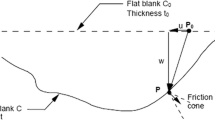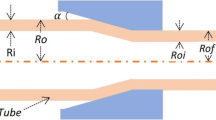Abstract
The use of the blanking process has been widely spread in mass production industries. In this technique, the quality of the final product is directly related to the setting parameters of the process and the material response of the sheet. In the present work, a general framework based on the finite element method for the simulation of the sheet metal blanking process is presented. The proposed approach properly addresses all the numerical challenges related to blanking. First, an extension of elasto-viscoplastic constitutive equations for the large strain regime is used to take into account the material strain-rate sensitivity. Then, the inertial effects coming from high velocity operations are considered by means of an implicit time integration scheme. Moreover, the frictional contact interactions are simulated with the classical Coulomb law and an energetically consistent formulation of area regularization. Finally, ductile fracture is modeled thanks to the element deletion method coupled with a fracture criterion. The blanking process is then simulated for different setting parameters. The accuracy of this approach is evaluated by comparing the numerical predictions to experimental results for both quasi-static and dynamic conditions. Good agreement is found between experimental and numerical results for all cases.


















Similar content being viewed by others
References
Lascoe OD (1988) Handbook of fabrication processes, Section 2C: Blanking operations, 119-292, ASM International, United States of America
Swift KG, Booker JD (2013) Manufacturing process selection handbook. In: Chapter 4: Forming processes, 93-140, Butterworth-Heinemann, United Kingdom
Tschaetsch H (2006) Metal forming practise Chapter 18: Shearing, vol 218-240. Springer, Heidelberg
Mucha J (2010) An experimental analysis of effects of various material tool’s wear on burr during generator sheets blanking. Int J Adv Manuf Technol 50:495–507
Popat PB, Ghosh A, Kishore NN (1989) Finite element analysis of the blanking process. J Mech Work Technol 18:269–282
Taupin E, Breitling J, Wu WT, Altan T (1996) Material fracture and burr formation in blanking results of FEM simulations and comparison with experiments. J Mater Process Technol 59:68– 78
Faura F, García A, Estrems M (1998) Finite element analysis of optimum clearance in the blanking process. J Mater Process Technol 80-81:121–125
Brokken D (1999) Numerical modelling of ductile fracture in blanking, PhD thesis. Eindhoven University of Technology, The Netherlands
Brokken D, Brekelmans WAM, Baaijens FPT (2000) Predicting the shape of blanked products: a finite element approach. J Mater Process Technol 103:51–56
Hambli R, Potiron A (2000) Finite element modeling of sheet-metal blanking operations with experimental verification. J Mater Process Technol 102:257–265
Rachik M, Roelandt JM, Maillard A (2003) Numerical simulation of sheet metal blanking predicting the shape of the cut edge. Key Eng Mater 233-236:329–334
Mediavilla J, Peerlings RHJ, Geers MGD (2006) An integrated continuous-discontinuous approach towards damage engineering in sheet metal forming processes. Eng Fract Mech 73:895–916
Lemiale V, Chambert J, Picart P (2009) Description of numerical techniques with the aim of predicting the sheet metal blanking process by FEM simulation. J Mater Process Technol 209:2723–2734
Subramonian S, Altan T, Campbell C, Ciocirlan B (2013) Determination of forces in high speed blanking using FEM and experiments. J Mater Process Technol 213:2184–2190
Metafor A C++ object-oriented Finite Element code for large strain problems, LTAS-MN 2L, University of Liège, http://metafor.ltas.ulg.ac.be/
Ponthot JP (1995) Traitement unifié de la mécanique des milieux continus solides en grandes transformations par la méthode des éléments finis, PhD thesis. University of Liège, Belgium
Ponthot JP (2002) Unified stress upyear algorithms for the numerical simulation of large deformation elasto-plastic and elasto-viscoplastic processes. Int J Plast 18:91–126
Perzyna P (1966) Fundamental problems in visco-plasticity. Adv Appl Mech 9:243–377
Simo JC (1992) Algorithms for static and dynamic multiplicative plasticity that preserve the classical return mapping schemes of the infinitesimal theory. Comput Methods Appl Mech Eng 99:61– 112
Ponthot JP (1998) An extension of the radial return algorithm to account for rate-dependent effects in frictional contact and visco-plasticity. J Mater Process Technol 80-81:628–634
Chung J, Hulbert GM (1993) A time integration algorithm for structural dynamics with improved numerical dissipation: the generalized-a method. J Appl Mech 60:371–375
Donea J, Huerta A, Ponthot JP, Rodriguez-Ferran A (2004) Arbitrary Lagrangian Eulerian methods, Chapter 14, Vol. 1: Fundamentals in Encyclopedia of Computational Mechanics. In: Stein E, de Borst R, Hughes TJR (eds). Wiley, New York
Boman R, Ponthot JP, Efficient ALE (2012) mesh management for 3D quasi-Eulerian problems. Int J Numer Methods Eng 92:857–890
Boman R, Ponthot JP (2013) Thermomechanical simulations of Highs-speed processes using the ALE formalism. Int J Numer Methods Eng 53:62–73
Moesdijk RD (1999) Numerical modelling of shape aberrations due to blanking, PhD thesis. University of Twente, The Netherlands
Wisselink H (2000) Analysis of guillotining and slitting - Finite element simulations, PhD thesis. University of Twente, The Netherlands
Manopulo N (2011) An ALE based FE formulation for the 3D numerical simulation of fineblanking processes, PhD thesis, ETH Zurich, Switzerland
Bussetta P, Boman R, Ponthot JP (2015) Efficient 3D data transfer operators based on numerical integration. Int J Numer Methods Eng 102:892–929
Wriggers P, Vu Van T, Stein E (1990) Finite element formulation of large deformation impact-contact problems with friction. Comput Struct 37:319–331
Wautelet G, Ponthot JP (2014) The influence of equivalent contact area computation in extended node to surface contact elements. Key Eng Mater 618:1–22
Oyane M, Sato T, Okimoto K, Shima S (1980) Criteria for ductile fracture and their applications. J Mech Work Technol 4:65–81
Johnson GR, Cook WH (1985) Fracture characteristics of three metals subjected to various strains, strain rates, temperatures and pressures. Eng Fract Mech 21:31–48
Wierzbicki T, Bao Y, Lee YW, Bai Y (2005) Calibration and evaluation of seven fracture models. Int J Mech Sci 47:719–743
Gurson A (1977) Continuum theory of ductile fracture by void nucleation and growth: Part I - Yield criteria and flow rules for porous ductile media. J Eng Mater Technol 99:2–15
Tvergaard V, Needleman A ((1984)) Analysis of the cup-cone fracture in a round tensile bar. Acta Metall 32:157–169
Lemaitre J (1992) A course on damage mechanics. Springer, Berlin
Besson J (2010) Continuum models of ductile fracture: A review. Int J Damage Mech 19:3–52
Jeunechamps PP, Ponthot JP (2013) An efficient 3D implicit approach for the thermomechanical simulation of elastic-viscoplastic materials submitted to high strain rate and damage. Int J Numer Methods Eng 94:920–960
Belytschko T, Lin J (1987) A three-dimensional impact-penetration algorithm with erosion. Comput Struct 25:95– 104
Ponthot JP, Boman R, Jeunechamps PP, Papeleux L, Delige G (2013) An implicit erosion algorithm for the numerical simulation of metallic and composite materials submitted to high strain rates, vol 79
Goijaerts AM (1999) Prediction of ductile fracture in metal blanking, PhD thesis. Eindhoven University of Technology, The Netherlands
Clift SE, Hartley P, Sturgess CEN, Rowe GW (1990) Fracture prediction in plastic deformation processes. Int J Mech Sci 32:1–17
Gouveia BPPA, Rodrigues JMC, Martins PAF (1996) Fracture predicting in bulk metal forming. Int J Mech Sci 38:361– 372
Gouveia BPPA, Rodrigues JMC, Martins PAF (2000) Ductile fracture in metalworking: experimental and theoretical research. J Mater Process Technol 101:52–63
Landrea J, Pertenceb A, Cetlinc PR, Rodriguesd JMC, Martins PAF (2003) On the utilisation of ductile fracture criteria in cold forging. Finite Elem Anal Des 39:175–186
Ozturk F, Lee D (2004) Analysis of forming limits using ductile fracture criteria. J Mater Process Technol 147(397):404
Leen SB, Krohn MA, Hyde TH (2008) A comparison of failure prediction methods for superplastic deformation. Int J Mater Form 1:1075–1078
Aretz H, Keller S, Vogt R, Engler O (2011) Modelling of ductile failure in aluminium sheet forming simulation. Int J Mater Form 4:163–182
McClintock FA (1968) A criterion for ductile fracture by the growth of holes. J Appl Mech 35:363–371
Rice JR, Tracey DM (1969) On the ductile enlargement of voids in triaxial stress fields. J Mech Phys Solids 17:201–217
Sun J (1991) Effect of stress triaxiality on micro-mechanisms of void coalescence and micro-fracture ductility of materials. Eng Fract Mech 39:799–805
Goijaerts AM, Govaert LE, Baaijens FPT (2001) Evaluation of ductile fracture models for different metals in blanking. J Mater Process Technol 110:312–323
Jana S, Ong NS (1989) Effect of punch clearance in the high-speed blanking of thick metals using an accelerator designed for a mechanical press. J Mech Work Technol 19:55–72
Rachik M, Roelandt JM, Maillard A (2002) Some phenomenological and computational aspects of sheet metal blanking simulation. J Mater Process Technol 128:256–265
Maiti SK, Ambekar AA, Singh UP, Date PP, Narasimhan K (2000) Some phenomenological and computational aspects of sheet metal blanking simulation. J Mater Process Technol 102:249–256
Acknowledgments
This research has been funded by the Interuniversity Attraction Poles Program (IAP 7/21) initiated by the Belgian Science Policy Office. C. Canales would also like to thank the FRIA-FNRS fund for its financial support.
Author information
Authors and Affiliations
Corresponding author
Rights and permissions
About this article
Cite this article
Canales, C., Bussetta, P. & Ponthot, JP. On the numerical simulation of sheet metal blanking process. Int J Mater Form 10, 55–71 (2017). https://doi.org/10.1007/s12289-015-1270-7
Received:
Accepted:
Published:
Issue Date:
DOI: https://doi.org/10.1007/s12289-015-1270-7




